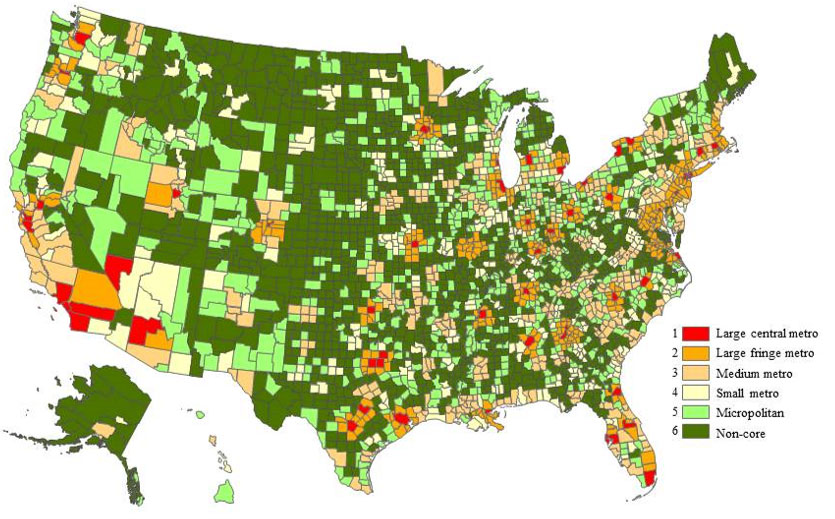Rural vs Urban Market Research
Over 60 million people live in Rural America
Understanding the difference between general and rural markets is key to planning a successful campaign.

Demographic Overview
| Extreme Rural | Rural | Suburban | Urban | |
|---|---|---|---|---|
| Gender | 50.2% Female, 49.8% Male | 52.7% Female, 47.3% Male | 52% Female, 48% Male | 51.7% Female, 48.9% Male |
| Average Age | 57 Years Old | 50 Years Old | 44 Years Old | 46 Years Old |
| Average Income | $49,000 Per Year | $55,000 Per Year | $63,000 Per Year | $76,000 Per Year |
| Race | 81.5% White 11.8% African American 6.0% Other 0.7% Asian |
85.3% White 6.7% African American 6.0% Other 2.0% Asian |
74.3% White 11.4% African American 8.9% Other 5.4% Asian |
66.1% White 14.6% African American 10.8% Other 8.4% Asian |
| Ethnicity | 92.8% Non-Hispanic 7.2% Hispanic |
89.3% Non-Hispanic 10.7% Hispanic |
84.7% Non-Hispanic 14.3% Hispanic |
79.1% Non-Hispanic 20.9% Hispanic |
| Average Number of People in Household | Eight of more | One | Six | Seven |
Job Market Overview
THE JOB MARKET IS VERY DIFFERENT IN RURAL VS. URBAN AMERICA
Understanding the difference between general and rural markets is key to planning a successful campaign.
| Extreme Rural | Rural | Suburban | Urban | |
|---|---|---|---|---|
| Operate Owned or Leased Farm | 241 | 133 | 88 | 48 |
| Agriculture, Forestry, Fishing, or Hunting | 343 | 152 | 44 | 37 |
| Mining or Construction | 45 | 172 | 92 | 102 |
| Manufacturing | 146 | 130 | 99 | 75 |
| Transportation, Communications, or Utilities | 102 | 78 | 76 | 123 |
| Wholesale and/or Retail Trade | 114 | 95 | 106 | 92 |
| Real Estate - Rental and Leasing | 105 | 64 | 55 | 141 |
| Management, Administrative Support or Waste Management | 293 | 29 | 101 | 53 |
| Sales | 110 | 67 | 122 | 92 |
| Production, Transport, or Material Moving | 151 | 96 | 70 | 104 |
| Other | 121 | 116 | 99 | 88 |
| Rural America | Urban America | |
|---|---|---|
| Employed Full Time 30+ Hours/Week | 93 | 103 |
| Employed Part Time <30 Hours/Week | 82 | 107 |
| Not Employed | 114 | 94 |
| Retired | 116 | 94 |
| Temporarily Unemployed | 114 | 94 |
| Disabled | 122 | 91 |
| Student | 76 | 109 |
| Homemaker | 114 | 95 |
| Never Worked | 121 | 92 |
Workforce: Rural America vs Urban America
Urban Americans work more than Rural Americans, but that is because of the stronger workforce in urban areas - and there are more job opportunities available.
RURAL AMERICANS LIVE IN A DIFFERENT AMERICA, COMPARED TO THEIR URBAN NEIGHBORS.
How different are they actually?
Rural American Background
- Rural Americans have greater attachment to their birth states than urban dwellers.
- 65.4% of Rural Americans live in their birth state.
- 48.3% of Urban Americans live in their birth state.
- Rural Americans hold different fundamental values; they:
- Empower themselves to be independent.
- Appreciate the hard work that goes into what they make and buy.
- Celebrate community and hometown traditions.
- Trust local communities more than mass media.
The first step in engaging rural consumers is to acknowledge that their needs are not typically the same as general-market consumers.
Rural vs Urban Different Opinions
- The divide between rural and urban communities is felt more in rural areas.
- They feel more separated and less understood, especially by marketers.
- 68% of Rural Americans feel their values are different than Urban Americans, compared to 48% of Urban Americans.
Rural Independence
- Rural America is very independent and has a strong renewed sense of self.
- 96% believe in having the right tools to be self-sufficient in today’s marketplace.
- People in rural areas empower themselves to be independent and appreciate the hard work that goes into what they make and buy.
- With the rise of machines, some people think no one needs anything handmade, but this is not true with rural consumers.
- 86% prefer handmade products because they symbolize “skill, craftsmanship & authenticity”.
- Rural consumers believe good innovation can come from anywhere, not just Silicon Valley.
- 96% feel small-town innovation deserves more recognition.
- 87% said they would rather support a local or national brand than a tech giant or conglomerate.
- This demographic responds positively to marketing messaging that celebrates their community pride.
- Homegrown pride is key with rural communities. 95% of rural Americans believe having a huge sense of pride in their community is important, in addition to taking pride in their country of origin.
Rural Values
- Community & Individual Values:
- Rural value system is primarily communitarian and relational
- People in rural areas empower themselves to be independent and appreciate the hard work that goes into what they make and buy.
- Rural consumers adopt individualism to survive in the larger economic & social environments
- Rewards in Rural Life:
- 86% prefer handmade products because they symbolize “skill, craftsmanship & authenticity”.
- Rural consumers believe good innovation can come from anywhere, not just Silicon Valley.
- The way people relate to each other in rural communities is more personal, emotional, direct, and socially supportive
- Urban residents relationships are categorized to a smaller social sphere of friends and acquaintances
- Efficiency of Rural & Suburban Life:
- Urban social interactions are more impersonal and indirect
Core Buying Behavior Influences
- There are three core values that influence Rural Americans’ buying behavior:
- Faith
- Community
- Family
- 41% of rural consumers said they are more likely to buy products and services that speak to their core values.
- Only 4% of Rural Americans said commercials or ads appeal to them.

Three Core Values
Faith
- Faith is the most important value to rural consumers. Faith is rooted into their everyday life.
- 45% of rural consumers say Faith is somewhat or critically important to them when making purchase decisions.
- 44% say Faith, as a marketing element, is effective at driving conversion.
- 30% of regular church-goers live in rural America.
Community
- Faith is the most important value to rural consumers. Faith is rooted into their everyday life.
- 79% of Rural Americans say family is a very important influence on their purchasing decisions.
- 49% of women and 41% of men in rural America say community is a very important influence on their purchasing decisions.
- 81% say word-of-mouth advertising is an effective purchasing tool.
Family
- Family is a core part of any person, but even more so in rural communities. It relates closely to Faith and their sense of community.
- 79% of Rural Americans say family is a very important influence on their purchasing decisions.
- 79% are more motivated to buy when a family is shown in an ad campaign.
- 62% of rural women rely on family input before buying.
CORE VALUES AND BELEIFS INFLUENCE RURAL AMERICA’S SHOPPING DECISIONS.
Let’s dive into how they’re buying…
Brand Loyalty in Rural America
Rural consumers look for businesses that reflect what they believe in. They look for the following in their favorite brands:
- Brands that value the people and the communities they live in.
- Brands that are honest.
- Rural Americans are hard working, and they expect the same from their favorite brands.
- Brands that play fair - Rural Americans don’t want to be played for profit.
- Brand generosity and charity efforts.
Rural Reasons for Shopping In-Store
- Rural residents are more likely to prefer shopping in physical stores because of convenience and cheaper prices.
- They are also more likely to say that the stores they prefer do not have an ecommerce presence.
- Urban consumers are more likely to prefer brick and mortar stores due to a belief that they offer a better selection of products.
| Rural | Urban | |
|---|---|---|
| Like to see or try items in person | 73% | 73% |
| Convenience | 42% | 39% |
| Better selection of products | 26% | 35% |
| Shopping is a social activity | 24% | 28% |
| Better sales/deals | 19% | 25% |
| Cheaper prices | 24% | 23% |
| Stores don’t have a website or mobile app | 9% | 6% |
| Rural | Urban | |
|---|---|---|
| Convenience | 56% | 31% |
| Cheaper prices | 47% | 38% |
| Better sales/deals | 39% | 32% |
| Better selection of products | 37% | 33% |
| Have Amazon Prime | 32% | 30% |
| Dislike shopping in stores | 7% | 13% |
Rural Reasons for Shopping Online
-
Nearly 2 in 10 Americans say they prefer shopping online, and the top 3 reasons for doing so are:
- Convenience
- Cheaper prices
- Better sales/deals
- For rural and suburban consumers, convenience is the top reason for preferring to shop online.
- Rural residents who prefer to shop online are also much more likely to believe that they don’t have good stores near them.
Online Purchasing Behavior
Rural consumers are adapting to making online purchases using their mobile devices. Of those rural consumers who do purchase items online, 51% use a computer while 42% use their smartphone.
- 36% of rural consumers purchased a product after seeing a mobile notification.
- 30% of rural consumers purchased a product after seeing an ad on TV.
- 25% of rural consumers purchased a product after seeing an ad on social media.
- 20% of rural consumers purchased a product after seeing a promotion in an email marketing newsletter.
- 19% of rural consumers purchased a product after hearing an ad on the radio.
- 13% of rural consumers purchased a product after seeing an online banner ad.
Device Shopping Behavior
Rural consumers are catching up to urban consumers with online purchasing, but all groups still prefer to shop on a computer over a mobile device.
Source: Fluent Company
